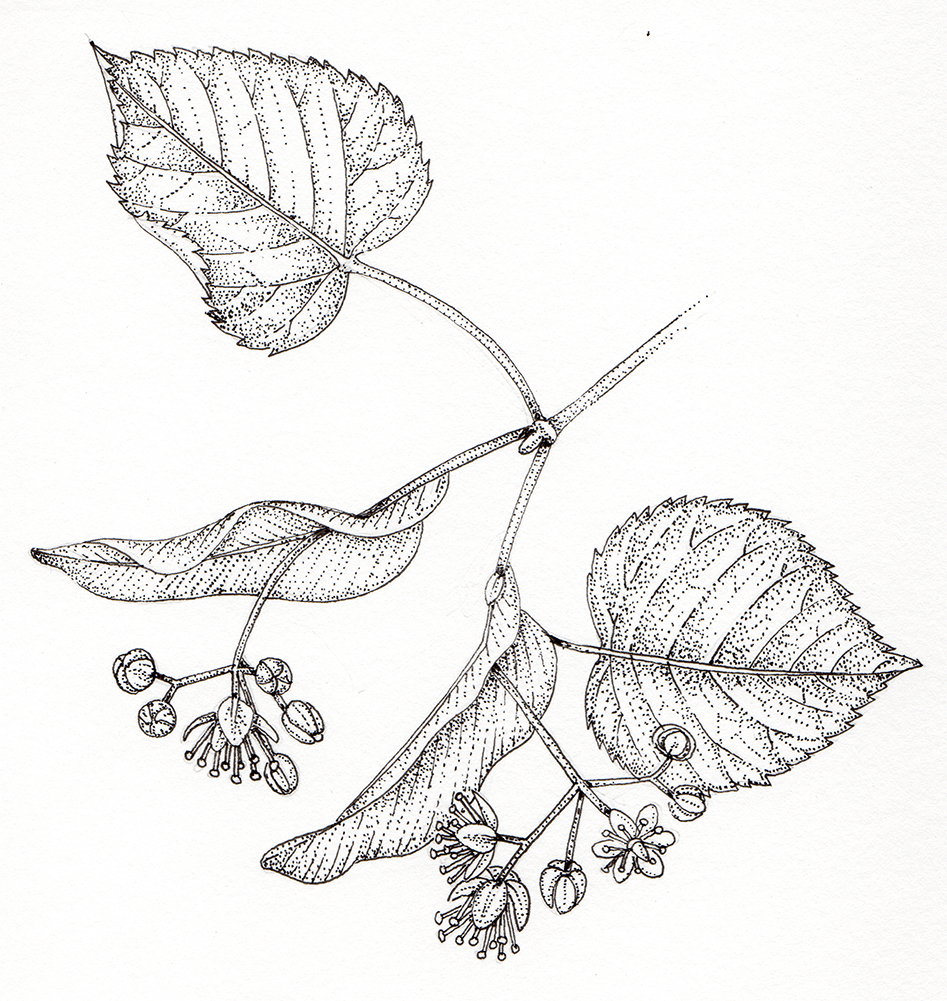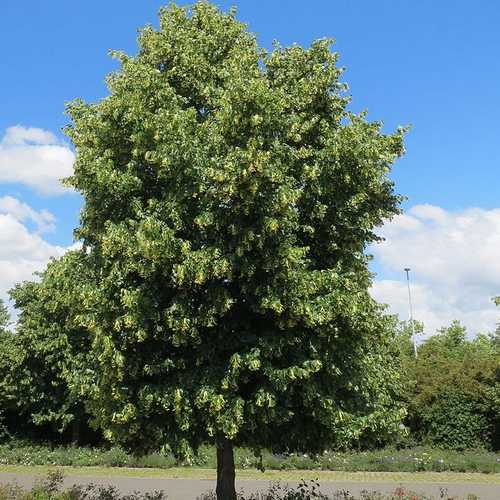Linden
Linden (Tilia cordata) is the herb of the month. It is a plant that everyone who knows it comes to adore because it’s so lovely, sweet, juicy, fragrant, and relaxing. And it’s good for our hearts, both physically and metaphysically (as you can infer from its heart-shaped leaves and Latin name). With American Heart month and Valentines Day coming up in February, I can’t think of a more appropriate herb to highlight.
 BOTANICAL NAMES: Tilia europaea, T. cordata, T. platyphyllos, T. americana
BOTANICAL NAMES: Tilia europaea, T. cordata, T. platyphyllos, T. americana
COMMON NAME(S): Linden flower, Lime blossom, Basswood, Linn Flowers, Spoonwood, Tilden Flower, Bee tree, Whitewood, Lime tree.
FAMILY: Tiliaceae
DESCRIPTION: a large deciduous tree, growing up to 130 feet tall with a trunk diameter usually of 2 to 3 feet, and a rounded crown. The flowers are intensely sweet and fragrant and beloved by bees. When in bloom, bees forsake most other flowers. The honey that bees make from linden nectar is regarded as some of the best honey in the world.
The leaves are heart-shaped and shiny. The bark is furrowed, and the wood is soft and light in color. It is easily carved and was used historically to make ship’s figureheads, broom handles, beehives and to make parts of instruments.
HISTORY/FOLKLORE:
- The Green Dryads or tree spirits were said to be wedded to Linden trees
- In Roman mythology the Linden was a symbol of conjugal love and fidelity
- Hildegard of Bingen used a talisman made of a green stone and lime flowers wrapped in a spider web to ward off the plague.
- In “the old days” in Germany, nearly every village had a green with linden trees where people gathered to decide business (possibly due to Linden’s calming effects)
- In the Pyrenees Linden is used to soothe spasms and excitement. The Ancients knew of Linden’s antispasmodic effects and used it for convulsion and epilepsy, as well as for all “nervous distempers” , fever and hyperactivity in children (Matthew Wood)
PARTS USED: Flowers and leaves primarily.
ACTIONS AND PROPERTIES: Nervine, antispasmodic, hypotensive, diaphoretic, diuretic, antioxidant, demulcent, anti-inflammatory, emmenagogue, astringent, nutritive
CONSTITUENTS: volatile oils, flavonoids (antioxidants) including quercetin, coumarin, mucilage, minerals, tannins, sugars, steroidal saponins, terpenes, vitamin C, amino acids, resins
ENERGETICS AND TASTE: Sweet, moist, cool, slightly sour and astringent
TISSUE STATES: Linden is balancing to heat, dryness and tension
USES:
Historical uses for Linden include: Appetite loss, Arrhythmia, arteriosclerosis, beverage, bladder problems, bleeding, burns (minor), cancer, colds, cough, diarrhea, dietary supplements, ear infection, epilepsy, fever, flavoring agent, gallstones, gargle/mouth rinse, gastrointestinal problems, gout, halitosis (bad breath), headache, hyperactivity, hypertension (mild/moderate), hysteria, indigestion, influenza, insomnia, irritability, kidney stones, laryngitis, menstrual problems, migraine, mucus, nervous conditions, night sweats, pain respiratory conditions, scurvy, skin problems, sore throat, sores, spasmodic conditions, tumors, vomiting, and wounds (minor).
Linden is primarily a relaxing remedy, used for nervous tension. Its relaxing effect on the nerves combined with its vasodilating effect on the blood vessels makes it a valuable ally in lowering blood pressure. It is considered a specific remedy in cases of raised blood pressure associated with arteriosclerosis and nervous tension and can be used to prevent arteriosclerosis and hypertension. Animal studies indicate that linden has anti-stress, sedative, and hypotensive (blood pressure lowering) effects. (American Botanical Council).
Its general relaxing action combined with an effect upon the circulatory system give Linden a role in treating some forms of migraine. It also protects the stomach against stress-induced ulcers. It has been shown to decrease adrenal enlargement and possess corticosteroid-sparing effects in rats under stressful conditions. As a diaphoretic, it induces a sweat and helps to resolve a fever. (Hoffman)
Herbalist Matthew Wood writes “It is suited to symptoms of kidney heat and irritation, including increased blood volume, essential hypertension, orthostatic hypertension, moist, warm skin, congestion of the kidneys, scanty, dark urine, and edema. It is cooling enough to work on herpes. The tongue calling for Linden flower is usually red, sometimes flame-shaped and usually somewhat moist.” (Wood)
Larger doses are used to promote restful sleep. The soothing mucilage provides an anti-inflammatory effect on mucus membranes in the digestive, respiratory and urinary systems.
Other Uses per Matthew Wood:
- Restlessness, hyperactivity, insomnia
- Nervousness, panic attacks and anxiety
- Nervous headache, migraine and dizziness, neuralgia
- Convulsions in children
- Influenza, fever, colds, coughs, mucus in the trachea and lungs
- Indigestion, nervous vomiting, painful digestion, colic, diarrhea.
- Heart palpitation, cramp
- Arteriosclerosis and hypertension associated with nervous tension
- Dark, scanty urine, edema
- Pelvic inflammatory disease, uterine pain, bearing down sensations, inflammation of the genatalia
- Fever with profuse sweat that does not relieve.
- Fever, chills, shivering, profuse sweat with no relief from fever
- Pain associated with heat, irritation and spasm.
- Itching, burning, eruptions, sores, herpes, shingles (external, the bark is beaten to soft fiber, simmered in cream, milk or milk and water, to make a soothing poultice)
CONTRAINDICATIONS / CAUTIONS:
Elisabeth Brooke gave this warning: Lime flowers act as a powerful sedative which when kept for over a year, has a narcotic effect. Therefore, strong doses of lime flower should be treated with respect and [one] should not operate heavy machinery or drive a car after taking them. Even so, if you take doses greater than those suggested, they are not dangerous. You will just fall asleep.
I have definitely used linden that I found stashed in the back of the cabinet that was over a year old and did not notice a strong hypnotic effect myself. There are also warnings about pregnant women avoiding linden due to its emmenagogue effect, but this is also a theoretical contraindication. Linden was not listed for any contraindications/concerns in Michael Moore’s book “Herbal/Medical Contraindications.”
PREPARATION AND DOSAGE:
- Tincture dosage is 2.5 to 5 ml three times a day (1:5 in 40%).
- Infusion preparation, pour 1 cup boiling water over 1 teaspoon of blossom and infuse in a covered container for 10 minutes. This should be drunk three times a day.
- For a diaphoretic effect in fever, use 2 to 3 teaspoons of blossoms per cup of water. (Hoffman)
PLANT SPIRIT/FLOWER ESSENCE AND / OR HOMEOPATHIC INFORMATION:
Calming emotional turmoil (Woodland Essences)
Linden from Delta gardens flower essences:
- Provides angelic relief to deep worry and anxiety.
- Steadies the “high-strung” or overexcited psyche.
- Helps balance cycles of work, play and rest.
COMBINATIONS:
- For atherosclerosis, combine linden with hawthorn and/or garlic (Hoffman)
- For hypertension, combine with cramp bark and skullcap (Hoffman)
- For nervous tension and insomnia, combine with hops
- For fever, combine with elderflower
REFERENCES:
- Brooke, Elisabeth, An Astrological Herbal for Women, The Crossing Press, 1995.
- Hoffman, David, Medical Herbalism: The Science and Practice of Herbal Medicine, Healing Arts Press, 2003.
- Rayburn, Debra, Let’s Get Natrual with Herbs: The Most Complete A-Z Reference Guide to Utilizing Herbs for Health and Beauty, Ozark Mountain Publishing, 2007.
- Wood, Matthew, The Earthwise Herbal: A Complete Guide to Old World Medicinal Plants, North Atlantic Books, 2008.
- nysite.com/nature/flora/page/basswd.htm
- http://www.deltagardens.com/ne_trees/linden.htm
- American Botanical Council. http://cms.herbalgram.org/herbalgram/issue51/article2318.html http://cms.herbalgram.org/herbclip/283/review44196.html
- gov. http://www.ncbi.nlm.nih.gov/pubmed/20085187
- http://www.ncbi.nlm.nih.gov/pubmed/18688792
- University of Maryland Medical Center. http://www.umm.edu/altmed/articles/linden-000263.htm
- A Modern Herbal. M Grieves. http://www.botanical.com/botanical/mgmh/l/limtre28.html
- Susun Weed. http://www.herbshealing.com/herbal_ezine/March07/healingwise.htm
- Garden Guides. http://www.gardenguides.com/79632-harvest-linden-flowers.html
- Delta Gardens. http://www.deltagardens.com/ne_trees/linden.htm
- Scents of Balance. http://www.scentsofbalance.com/products/flower_essences.htm
- An Elder’s Herbal. David Hoffman.
- The Complete Illustrated Holistic Herbal. David Hoffman
- Michaels Moore’s Website.
- http://www.swsbm.com/Dispensatory/USD-1918-complete.pdf
- Herbal/Medical Contraindications. Michael Moore.
- Sharol (N.D) http://www.herbaltransitions.com/materiamedica/Tilia.htm
- Oklahoma Biological Survey. http://www.biosurvey.ou.edu/shrub/tiamx.htm
- The Practice of Traditional Western Herbalism. M Wood
This Article is for education purposes only. These statements have not been evaluated by the FDA. They are not meant to diagnose, treat or cure any disease.


